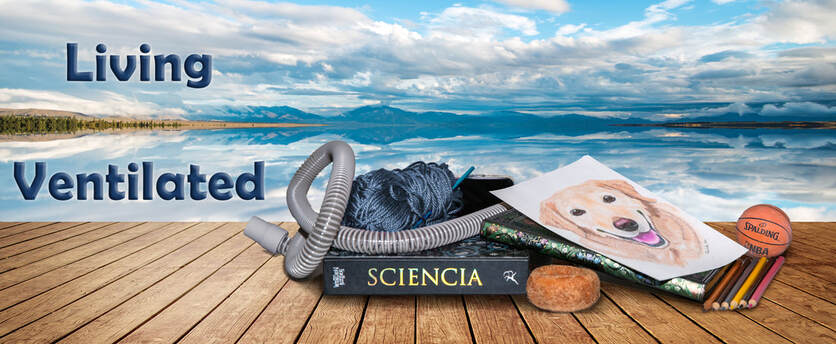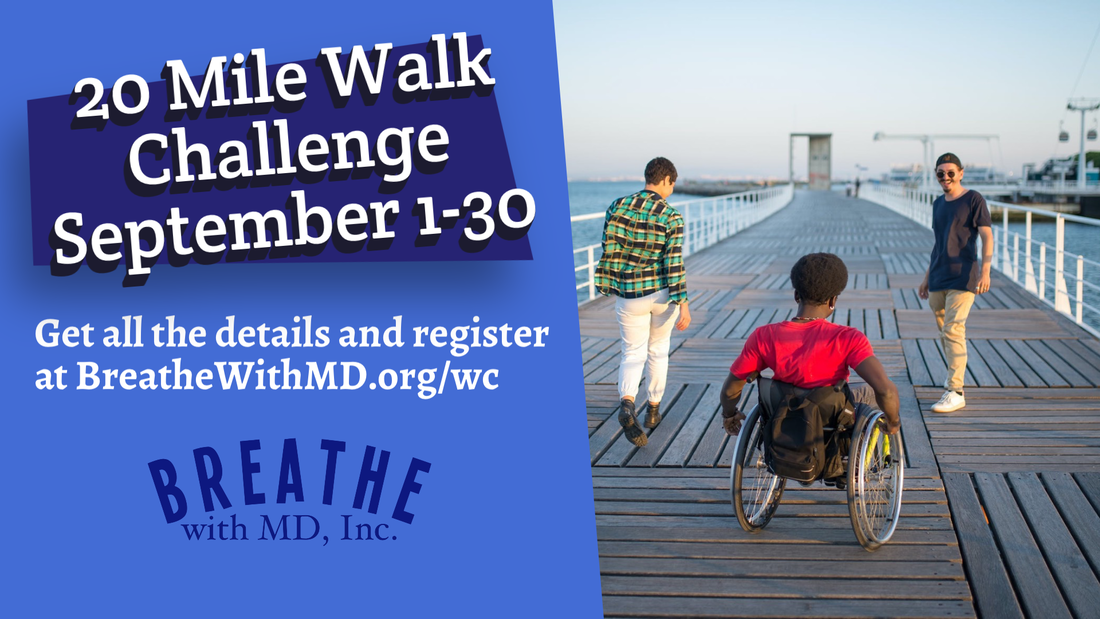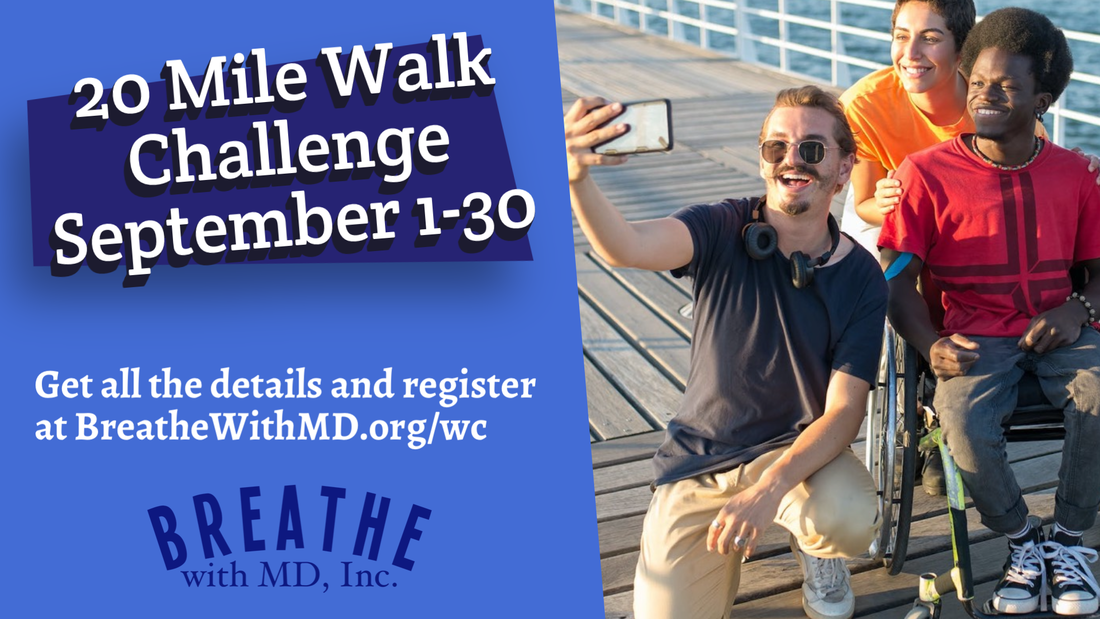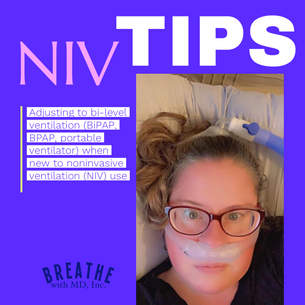If you have any questions at all about our 20 Mile Walk Challenge, don’t hesitate to contact us. Unsure how to create a Facebook fundraiser for the challenge? We can coordinate a time to help you; just let us know. We will encourage and cheer you on during September in our private Facebook group, “20 Mile Walk Challenge.” We appreciate your support and look forward to working with you! By Andrea Klein Founder & President, Breathe with MD, Inc. I recently asked our Breathe with MD Support Group members for their tips for individuals living with Neuromuscular Disease (NMD) to adjust to bi-level non-invasive ventilation (BiPAP, BPAP, portable ventilator). Below are their thoughtful, experience-based tips. “Don't get discouraged. It takes time to get used to it, but in the long run, your body NEEDS the support for better sleep and less daytime fatigue.” - JC “Make sure your mask works for you! Size and style are very important. You always have options.” - LJ “My DME company gives me a two-week window to try a new mask without issue, and I love that they do that! If my mask style/size isn’t comfortable, I can change to something different in that two-week time, and then try the new mask for an additional two weeks. That’s something a new person should ask about, because a lot of times, people think they hate the machine when really they just hate their mask! I tried a smaller mask (or maybe nose pillows?! I can’t remember now, it’s been a while ago), that wouldn’t let me talk while I had had it on. Might not be a big deal to some, but I was totally freaked out! I HATED THAT. I’m so grateful I could switch, and now I have a mask that works great for me!“ - GL “Keep in contact with your respiratory therapist. A tincture of patience and a good working relationship may be required.” - SF “First, set the ramp time for as long as possible: 45 minutes is the longest I’ve seen. By the end of the 45 minutes, you’ll probably be asleep. Most insurances require at least 4 hours of usage each night, so set your alarm for 4 hours to meet their requirement. Do the 4 hours for 3 nights. On night 4 increase the time to 4 hours 15 minutes. Use that time for 3 nights. For night 7, increase the time to 4:30 for the next 3 nights. Keep increasing the time by 15 minutes every 3 nights until you get tired of waking yourself up to take off the mask and start sleeping through the whole night. Humidifier is your friend. IMO dry mouth is the biggest turn by off to using the equipment: waking up with a mouth so dry you can’t spit. Humidifier is a combination of tank temperature and how much humidity you want. It’s 2 separate settings on some machines. Getting used to a mask can be helped by wearing just the mask with no hose attached in the evening, before using it with everything connected.” -BY “My pulmonologist had me increase by an hour every few nights if possible. I found I needed two different masks due to my skin having some breakdown. Finding the right mask can be part of the challenge too so really take time with making sure no leaks and no pressure etc. I also found the bipap setting where it automatically turns on and off for you rather than you having to push the button on and off when connecting/disconnecting helps.” - LM “If you can’t tolerate the mask, try nasal pillows. Once I got the pillows, it was easy to tolerate. I’m up to 6 hours a night. That’s when my humidifier runs dry, and I wake up when my mouth dries out. I keep a water bottle by my bed.” - CD “If it feels wrong, it probably is. Make the call to respiratory for settings adjustments. Also, be aware that BiPAP isn't right for everyone and an active circuit ventilator setting may work better for you.” - KS “When I first got a bi-pap I only used it for a couple minutes during each day. Eventually, I worked my way up to being able to watch a movie during the day. Once you can handle having it on for a few hours then switch to only sleeping with it. I definitely wouldn’t try using it for the first time at night because it is a very weird feeling at first.” - KC “Most offices fit the mask while you are sitting upright. That’s totally wrong because your facial muscles sag when laying down. I found that when I asked to lay down to try on a mask and adjusted the straps laying down I got a better fit. RT at pulmo’s office had never heard of doing that. But now she does have the patients lay down to try a mask on and they do better when they use it that night.” - BY “Contact the doctor who prescribed it if things are off. For example, when I got my current BiPAP the amount of time for inhaling was just a second or less and the amount of exhale time was for many times longer. I need a longer inhale time than what the machine was set for. The machine wasn't giving me a second breath when I needed it as it was still on exhale mode. One phone call, and within an hour it was changed. The machine I have is set by the RT remotely, but only on doctor's orders. Keep telling you doctor or RT what isn't working so adjustments can be made. Expect it to feel weird at first. Learn to relax whilst using it during the day. Once the breathing cadence and mask are comfortable, work up to wearing it for one hour during the day. Then start using it at night.” - DD “If something's not OK, try to pin down what it is: 'Too fast,' 'Can't breathe out enough' for me meant the span (IPAP minus EPAP) was too low. 'My face is squashed” - get a different mask 'It's leaking in my eyes!!!' - lay a sock over your eyes and get a different mask. 'What does the problem feel like?'” - FP What tips do you have for someone getting adjusted to NIV? What worked for your successful adjustment?
|
AboutLiving Ventilated celebrates those in the NMD community who use assisted ventilation. Archives
August 2024
Categories |
Breathe with MD, Inc. is a U.S. registered 501(c)(3) nonprofit organization. Donations are tax deductible to the extent allowable by law.
Note: This website should not be used as a substitute for medical care. For medical care or advice, please seek the care of a clinician who specializes in the breathing issues of those with Neuromuscular Disease (NMD).
Web Hosting by Hostgator
Note: This website should not be used as a substitute for medical care. For medical care or advice, please seek the care of a clinician who specializes in the breathing issues of those with Neuromuscular Disease (NMD).
Web Hosting by Hostgator





 RSS Feed
RSS Feed